Dominating the cover of the May 1972 issue of Motorcyclist is the Yankee 500 Twin or "Z500," developed in Schenectady New York, with motorcycling legend Dick Mann in coordination with the Spanish firm Ossa.
The Yankee Twin is a mating of two Ossa 250cc Pioneer singles sharing crankcase. One complaint commonly mentioned in the same breath with the Z500 is weight. Bob Greene; then publisher and editor of this tome, points out that the complete engine, trans, kick lever, carbs with velocity stacks, and short dummy exhaust (pictured on the May '72 cover above) weighs 112 pounds, 7 oz. Greene also states that due to the short stature of this engine, it carries the weight down low which he found to be complimentary for this enduro.
The 360° and simultaneous firing order this mill should be considered a “Twingle.” The configuration was settled upon after early 180-degree tests produced a power pulse every half revolution resulting in instantaneous power. The smooth and immediate power caused the rear wheel to break loose with the slightest nudge of the throttle.
Bob Greene performed lengthy tests of the 500 Twin in both Upstate New York and over on the West Coast in the California desert. These tests revealed a lot of detailed information about how the bike and engine combination performed in varied conditions. Also in great supply was technical data. The team at Yankee had many motorcycling first detailed in this article.
Among the firsts were a rear hydraulic disc brake, a rectangular tube swingarm. Greene goes into specific detail on almost every feature of the motor and chassis in this 10 page test. If you were to restore one of the known 760 Yankee 500 Twins (ever produced) between 71-73, a copy of this article may come in handy.
Two months and 1200 miles aboard the 1972 R-75 have prepared Bob Greene to field any question about this machine. Greene was the Motorcyclist editor back in '72 who spoke to the quality and construction of the BMW and also highlights the merit of the aircraft-inspired opposed twin that has been the main configuration of most of the machines coming out of Germany virtually unchanged in 45 years.
Throughout the article Greene uses words like craftsmanship, beauty, workmanship and uniqueness. “Even in the darkest and remote corner BMW there are no “rough edges” down underneath or in behind the most mundane component.” Noted for its durability and popularity with the commercial “shagger” (or mounted messenger) the motor is smooth and delivers plenty of power.
He goes on at length about cruising along right around the century mark on the speedometer and has no complaint with the delivery of power. Where fault is put is into the front suspension. On typical concrete slab freeways there is still a faint trace of fork bearing stiffness inherent (yet improved) in the '71 model. The result was a bucking in the front end of up to 1” of travel. Fortunately, this did not translate into steering issues, just rider fatigue. The author combated this front end vibration by merely lightening up his hold on the bars and gripping the tank with his his knees and driving his back side into the the seat.
Some neat things included in this article were riding two up and adding an aftermarket Avon fairing and luggage, and how these things affected performance. Other factors considered were fuel economy of between 41.3 mpg (the day the wind blew)and 46.2 mpg with an average of 43.2 under all circumstances. Based on these numbers, the R-75 should be able to deliver 165 miles with a 20 mile reserve.
As far as comfort goes, on one 175-mile stretch of two-up riding, the seat never became uncomfortable and the footpegs appeared to be well placed - well, sort of. The left pilot peg presented an issue to the author with a size 8 foot. When attempting to slide his boot down to shift the transmission there was some interference with the carb intake. Noted in the same paragraph is the fact that a larger foot would not experience this issue. What was learned is that the pivot point of the instep placed the foot on the author's size 8 in an awkward position.
By 1972 prices, the $2095 price tag from either Norwood, NJ, or Compton, CA, ports of entry plus freight, possible setup charges, sales tax and license is “getting up there”. Also noted was that it was still a step or two below the “Big Harley”. When Greene was asked to compare to the Harley, he stated that there is no comparison: “apples and oranges.”
The article chronicles all of the features of the new R-75. Most of them which are special and in some cases unique to the BMW. Most notably would be the opposed twin with smooth manners but include: electric start, shaft drive and design features to make the machine work better. One feature of special note is the center stand which over balances when either wheel is removed to allow maintenance.
Summed up, the bike had superb manners, uncanny quietness, and lots of trick goodies. You might be able to find bigger performance but you won't find the efficiency, dependability, handling, workmanship or all-around touring attributes at any price in 1972.










/cloudfront-us-east-1.images.arcpublishing.com/octane/X55P25KKUXMTVYCMK3MRTPI3PU.jpg)
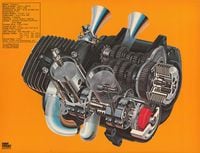

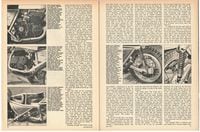

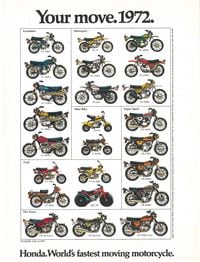


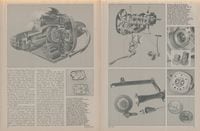

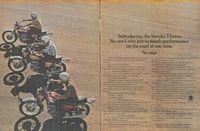
/cloudfront-us-east-1.images.arcpublishing.com/octane/GTCXACQGJ5HAPDTGWUQKDEH44E.jpg)
/cloudfront-us-east-1.images.arcpublishing.com/octane/S35YGSEMEZB4BLTDJTSZPF4GLA.jpg)
/cloudfront-us-east-1.images.arcpublishing.com/octane/5UOT6HPX2JFMRJAX6EH45AR4MQ.jpg)
/cloudfront-us-east-1.images.arcpublishing.com/octane/OKWOJWAKP5EP3OACCRRWPCIX2Q.jpg)
/cloudfront-us-east-1.images.arcpublishing.com/octane/2WF3SCE3NFBQXLDNJM7KMXA45E.jpg)
/cloudfront-us-east-1.images.arcpublishing.com/octane/G4MG6OUCJNBSHIS2MVVOTPX65E.jpg)
/cloudfront-us-east-1.images.arcpublishing.com/octane/IIGGWFOTOJGB7DB6DGBXCCMTDY.jpg)
/cloudfront-us-east-1.images.arcpublishing.com/octane/QSTCM6AVEZA5JJBUXNIQ3DSOF4.jpg)
/cloudfront-us-east-1.images.arcpublishing.com/octane/U4I7G625B5DMLF2DVIJDFZVV6M.jpg)
/cloudfront-us-east-1.images.arcpublishing.com/octane/B6XD6LS6IVCQPIU6HXDJSM3FHY.jpg)
/cloudfront-us-east-1.images.arcpublishing.com/octane/ICL63FEDDRDTTMINYICCEYGMDA.jpg)
/cloudfront-us-east-1.images.arcpublishing.com/octane/FCGZHQXRBZFLBAPC5SDIQLVF4I.jpg)
/cloudfront-us-east-1.images.arcpublishing.com/octane/WNOB6LDOIFFHJKPSVIWDYUGOPM.jpg)

/cloudfront-us-east-1.images.arcpublishing.com/octane/X33NU3E525ECRHXLNUJN2FTRKI.jpg)
/cloudfront-us-east-1.images.arcpublishing.com/octane/6KKT5NNL2JAVBOXMZYS5ZO76YA.jpg)
/cloudfront-us-east-1.images.arcpublishing.com/octane/J5RKG5O455GMPGQRF2OG6LRT7A.jpg)
/cloudfront-us-east-1.images.arcpublishing.com/octane/GX2CIZKQVRH2TATDM26KFG2DAE.jpg)
/cloudfront-us-east-1.images.arcpublishing.com/octane/ZWIDYSAKQZHD5BHREMQILXJCGM.jpg)
/cloudfront-us-east-1.images.arcpublishing.com/octane/CYUHJZCTSJCH3MRAQEIKXK7SCQ.jpg)
/cloudfront-us-east-1.images.arcpublishing.com/octane/LKOFINY56FCXJCANJ5M7ZDQUBY.jpg)
/cloudfront-us-east-1.images.arcpublishing.com/octane/4NBPDACMWJH63JQYJVK3QRBDZI.jpg)
/cloudfront-us-east-1.images.arcpublishing.com/octane/KKHQHRR3FJGX7H2IPU6RALMWG4.jpg)
